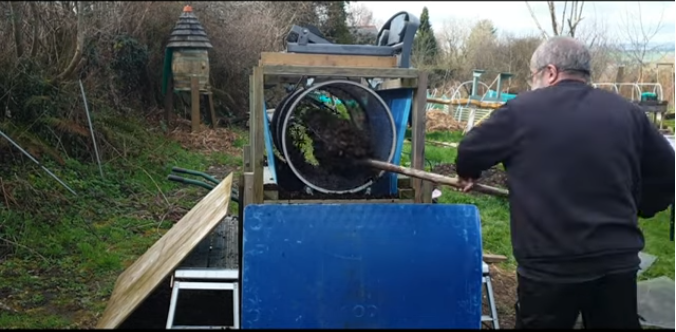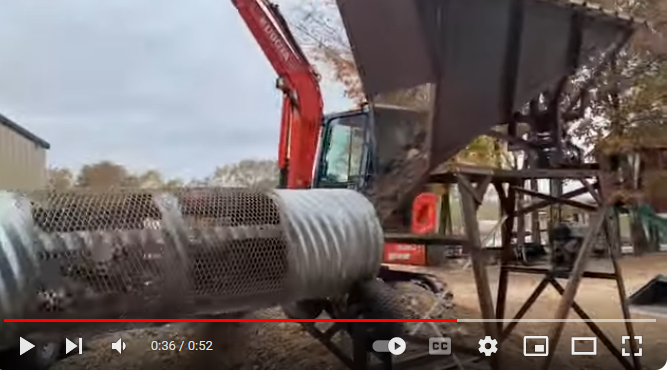709-218-7927 The Landfall Garden House 60 Canon Bayley Road Bonavista, Newfoundland CANADA A0C 1B0 |
|---|
Sieves
Sieves have two basic functions:-
(1) Separating Materials; for example separating rocks and pebbles from soil
(2) Mixing Materials; for example mixing grass clippings and sawdust with soil, to make a compostable mixture.
Your first step should be to clarify what you want to do. Do you really need to make a fine-grain soil with no pebbles or wooden debris at all? Do you need to separate plastics from the material? You might end up with a variety of sieves to serve differetnt purposes. A sieve to separate grass clippings from sawdust will be different from a sieve used to mix grass clippings and sawdust.
I have separated my sieves into Racks and Trommels.
A Rack is a two-dimensional rectangular frame with a fitted mesh screen.
A Trommel is a three-dimensional drum made from a cylindrical mesh screen.
I define a Mat as a stand-alone piece of mesh that can be fitted in or dropped in to a sieve.
If your Rack is made with six-inch mesh, you can drop a one-centimetre mat of mesh on top of the six-inch mesh that makes the frame, and sieve out all dross that is greater than one centimetre in diameter.
If your Trommel is made with six-inch mesh, you can roll a one-centimetre mat of mesh into the one-inch mesh that makes the cylinder, and sieve out all dross that is greater than one centimetre in diameter.
A mat can be much longer than the rack or frame. For example, if your structural cylinder is eighteen inches long and a bicycle rim in diameter, you can roll a thirty-inch long mat into the cylinder, making a trommel with an effective length of thirty inches instead of the structure which is only an eighteen-inch cylinder. Such a technique can increase the time that raw material undergoes sieving.
The models that follow have two basic characteristsics:-
(a) Interchangeable modules
Mats are interchangable.
Racks should be interchangeable; the Propped Rack is a rack that is propped up at an angle. That Rack should be usable in a Dropped, Vibrating, or Cammed rack configuration
(b) Compact storage. Bonavista winds are strong. Once work on soil remediation is completed for the year, we want to dis-assemble the devices and store them in the shed. The day I write this we are enjoying wind gusting up to 100 Km/hour.
The rack/trommel you use will depend on your job. I need 1,000 cubic feet of sifted soil to fill my new 24’x16’ raised bed. I would rather burn mains electricty to agitate the sieve than add hand-agitation to my hand-shovelling of soil from the ground to a point above the level of the sieve.
Each situation changes a preference for Sieves. I live alone, wake at sunrise, which means that in late spring and summer I am awake and “rarin’ ter go”. Barrowing grass clippings is a quiet task that does not annoy my neighbours. A propped-sieve is less likely than a powered trommel to annoy ny neighbours at 0400 hours.
Caution: In the videos linked from these pages, some will be close to your interests (“separating rocks from soil”) and some will not “The Most efficient way to separate worms and castings”), so don’t be driven by a dead-easy separator if it won’t serve your needs. But DO look out for “neat tips” that can be adapted to your idea of a sieve.
Racks
(1) Hand Rack
(2) Propped Rack
(3) Dropped Rack
(4) Vibrating Rack
(5) Cammed Rack
Trommels
I believe this is a potato trommel. It separates spoil from potato vines, and separates tubers from the vines. It is motor-driven and if I could have found one second-hand for $200 I would have bought it.

Many powered trommels seem to me to rotate too quickly; material spends a lot of time arcing across the diameter of the sieve. I theorize that more mass will be sieved at a slower speed – macimize contact with the mesh. Too I worry that the arcing means coarse material impacts the mesh and wedges itself into the meash, instead of sliding across the mesh and out of the end.
In this model the owner has installed several skirts to trap errant material. Good. But consider an entry funnel so that material can be loaded in the other direction. Stand alongside the trommel and toss material into the funnel or chute, and have it slide into the mesh to maximize the time spent in contact with the available length of mesh.

Here is a monster funnel being fed by a bucket hoe; admittedly high, but illustrates the point.
(9) Belt Trommel
(10) Hybrid Sieves
Construction